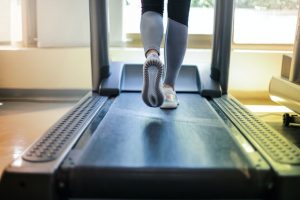HIIT can be an easier way to do cardio. Find out the benefits of regular Cardio vs HIIT, how it has made cardio less painful for me, why cardio is necessary, and how to do HIIT.
What is Considered Cardio?
Trevor Thieme, C.S.C.S. and Openfit’s senior manager of fitness and nutrition content says, “Cardio is anything that A) raises your heart and breathing rates, and B) improves the function of your heart, lungs, and circulatory system (Heffernan, 2020).”
Cardio Love It, Like It, or Hate It?
I personally was not a fan of cardio for a very long time. I’m not even sure why I joined track in high school. Like running was painful a lot of the time, not fun. I suppose I enjoyed track meets even though I wasn’t very good. But I still have no clue why I did for 5 years, especially hurdles. I know I joined tennis because I had a ton of friends doing it and that made it super fun.
 Anyway, I enjoy cardio exercise if I’m doing outdoor sports, but getting in cardio exercise 3 times a week is super hard especially in the Winter. For years I didn’t bother doing cardio exercise. In the cold months I would just walk on my treadmill for exercise. I thought just getting exercise was good enough. But then I learned about HIIT along with how important cardio is, and that changed things for me. HIIT made cardio exercise less painful for me, less time consuming, and more rewarding.
Anyway, I enjoy cardio exercise if I’m doing outdoor sports, but getting in cardio exercise 3 times a week is super hard especially in the Winter. For years I didn’t bother doing cardio exercise. In the cold months I would just walk on my treadmill for exercise. I thought just getting exercise was good enough. But then I learned about HIIT along with how important cardio is, and that changed things for me. HIIT made cardio exercise less painful for me, less time consuming, and more rewarding.
My husband was also not a huge fan of regular cardio exercise and was all about strength training, but I told him cardio is just as important and encouraged him to try HIIT. Once he started he didn’t need me to push him to do it. He noticed the mental and physical benefits and now regularly does HIIT 3 times a week.
Before I talk about HIIT… Why Do We Need Cardio?
Cardio Exercise will Help Reduce the Risk of Both Chronic Illnesses and Deadly Diseases.
 Cardio exercise is one way you can reduce the risk of heart attacks and disease along with their underlying causes such as high blood pressure and cholesterol (Top Fitness Store, 2019). It can even help with prevention of diabetes, cancer, Alzheimer’s, osteoporosis, and obesity.
Cardio exercise is one way you can reduce the risk of heart attacks and disease along with their underlying causes such as high blood pressure and cholesterol (Top Fitness Store, 2019). It can even help with prevention of diabetes, cancer, Alzheimer’s, osteoporosis, and obesity.
Physical Health Benefits Include
- Strengthens the immune system
- Helps you to take in more oxygen
- Pumps blood to your working muscles
- Increases lung capacity
- Improves heart efficiency slowing resting heart rate
- It helps your body to release toxins (clears carbon dioxide and other waste products from your system)
- Improves joints
- Improves sleep: makes it easier for you to fall asleep and you get better REM sleep (I’ve personally noticed on days I’m more active I sleep better at night.)
- Helps with weight loss
- Increases energy
Mental Health Benefits Include
- Improves mood (can help with depression)
- Reduces stress
- Improves mental clarity
What is HIIT? Why Do HIIT?
Disclaimer: This is not exercise that is a good choice for everyone and anyone. Depending on your age, health issues, and physical health overall this might not be a good fit for you. Check with your doctor first.
 Gyms often offer exercises that combine strength training and refer to them as HIIT, but they often don’t fit the criteria for being a HIIT exercise. When researchers talk about HIIT, they’re referring to workouts that alternate hard-charging intervals, during which a person’s heart rate reaches at least 80 percent of its maximum capacity usually for one to five minutes, with periods of rest or less intense exercise (Belluz, 2019).
Gyms often offer exercises that combine strength training and refer to them as HIIT, but they often don’t fit the criteria for being a HIIT exercise. When researchers talk about HIIT, they’re referring to workouts that alternate hard-charging intervals, during which a person’s heart rate reaches at least 80 percent of its maximum capacity usually for one to five minutes, with periods of rest or less intense exercise (Belluz, 2019).
An example of HIIT is if you run super fast for 1 minute, walk for 1 minute, run for 1 minute, walk for 1 minute, run again, walk again, run again and walk again. It is usually recommended to do at least 4 intervals. Of course, you would want to do a warm-up and cool-down, as well. You could also run for 4 minutes and walk for 3 minutes doing 4 intervals, or do 1 minute of high intensity followed by 3 minutes of recovery and do 4 intervals. Here is a lab tested interval training to try: 4×4.
HIIT doesn’t have to involve running. There are many ways to do HIIT training you can find a HIIT training video from YouTube (no equipment needed), workout on a treadmill, an elliptical, run and walk outside, bike, swim, do cross-country skiing, etc. There are many sports where you can utilize interval training.
How to Calculate Your Heart Rate
Benefits of HIIT
Saves Time
 HIIT training has been shown to deliver the same or even more benefits in less time. Routines that are nearly 20 minutes of HIIT haven been shown to burn around the same amount of calories as exercise with a continuous pace lasting 50 minutes according to multiple research studies. However, HIIT does not cause people to lose more weight than other forms of exercise. It will perform about the same as doing longer exercises at a continuous pace. Exercise is not the key to weight loss anyway, it is a necessary component but you can’t outrun your fork. You have to change your diet to really reach your weight loss goals.
HIIT training has been shown to deliver the same or even more benefits in less time. Routines that are nearly 20 minutes of HIIT haven been shown to burn around the same amount of calories as exercise with a continuous pace lasting 50 minutes according to multiple research studies. However, HIIT does not cause people to lose more weight than other forms of exercise. It will perform about the same as doing longer exercises at a continuous pace. Exercise is not the key to weight loss anyway, it is a necessary component but you can’t outrun your fork. You have to change your diet to really reach your weight loss goals.
Another similar exercise called SIT (exercising at 100 percent of the heart’s capacity) has been shown to work as well as HIIT with a lot of the same benefits. In 2016, a study was done on SIT comparing a group of people doing just 10 minutes of SIT exercise regularly for 12 weeks vs a group doing 50 minutes of exercise at a continuous pace. It was found that both groups had the same improvements in oxygen levels.
Heart Health
Interval training (HIIT and SIT) largest benefits have to do with cardio-respiratory health, as interval training provides a larger volume of oxygen to the body. This can help prevent heart disease.
From Vox: “Scientists have found that [VO2 max] is one of the best predictors of overall health,” according to the recent interval training book The One Minute Workout, co-authored by Martin Gibala, one of the world’s leading interval training experts, who’s based at McMaster University in Canada. “The more aerobically fit you are, the better your heart can pump blood, the longer it takes you to get out of breath, and the farther and faster you’re able to bike or run or swim.” And that, in turn, can help prevent heart disease (Belluz, 2019).
Improving Performance

Athletes use HIIT to improve their performance.
Many athletes utilize interval training and find improvements in their speed, recovery time and overall performance even with just two interval training sessions.
Recovery is critical for athletes in sports like tennis, basketball, soccer or hockey, where the sport demands continuous stops and starts, or an endurance bike ride or road race where you hit hills and need to catch up quickly at the top in order to keep your pace (Weil, 2021). It helps your muscles switch quickly between aerobic (more fat-burning) and anaerobic (more carbohydrate-burning). Many sports demand starting and stopping, and a person who practices interval training will switch quicker. So they will be able to more easily catch their breath when switching from a high intensity exercise to a resting point.
Post-Workout Calorie Burning
Another advantage of a HIIT workout is the ability to burn calories post-workout due to your body going through a repair cycle for 24 hours afterward.
How to do HIIT Training
You will need a heart rate monitor or a FitBit to track your heart rate. To effectively do HIIT you need to know what your resting heart rate is and heart rate for your intense interval.
With HIIT training it is important to do at least one day of rest in-between each HIIT training session. Overtraining can lead to a numerous problems including performance issues, extremely sore muscles, sleep difficulties, injuries, and more. Also, if you are new to HIIT just start off doing it once a week and work up to two to three a week.
How to do HIIT Correctly
According to the below video, HIIT training should actually be 30 minutes to 1 minute training to truly get your heart rate to up to 80% of your maximum capacity. There is a debate on whether longer intense intervals make a bigger difference. In my opinion, you have to just try and see what works best for you, which is also mentioned in the video below and that is why I included it. He also talks about your relaxed interval being the time frame that works best for you.
How much cardio do we need?
About 25 minutes of cardio 3 times a week is sufficient based on the American Heart Associations recommendations. So I think if you are doing HIIT that could look something like 10 minutes of warming up, 1 minute running, 3 minutes walking as a set of 4, and then a 5 minute cool down.
Note: That is just one example of a HIIT workout.
Why I Love HIIT
 I can get some of the same benefits of a longer cardio workout in less time!
I can get some of the same benefits of a longer cardio workout in less time!
Instead of exhausting myself doing running constantly for 30 minutes (plus 10 minutes of a warm up and cool down), I can do a warm up, 4 intervals of high intensity running followed by a relaxed walking, do a cool down all in 25 minutes and still get all the benefits. This is what I do on my treadmill, and at first I didn’t like it, but now it’s just a normal and natural thing. Sure there are some days where I can’t do cardio because I’m not feeling well or sore from another exercise, but it is for the most part a habit I stick to.
I personally do 30 seconds of high intensity or a full minute. For my walking intervals, sometimes I do a minute of walking and other days more. If you haven’t done any HIIT training, it could be beneficial to just start with some HIIT training programs and see how they make you feel.
Don’t forget the water! Reduce Water Bottle – Hydro Pure 28 oz Buy Here.
View All Wellness Lifestyle Blog Posts:
What It Means To Live A Wellness Lifestyle & Why It Matters
How an Unhealthy Spine Can Cause Numerous Problems
How Relationships Influence Our Health (in multiple ways) & Our Success
Managing 3 Stages of Stress (Conscious, Hidden Stress & Preventing It)
How Exercise Can Be Natural & Fun
Nature Heals the Soul, Calms the Mind & Restores the Body
Everything You Need to Know About Supplements
How to Sleep Better & What to do When You Can’t Sleep
Importance of Each Sleep Stage, Sleep Schedules & More
How to Increase Water Intake & Choosing Clean Drinking Water
Key to Wellness: Listening to Your Mind, Body, Spirit/Soul
Addicted to Your Phone? Ideas for Spending Less Time on Your Phone
References:
Belluz, Julia. (2019, December 26). VOX/How to get the most out of your exercise time, according to science. Retrieved from: https://www.vox.com/science-and-health/2019/1/10/18148463/high-intensity-interval-training-hiit-orangetheory
Weil MEd, Richard. (2021, July 19). MedicineNet/What Are the Benefits of Interval Training?. Retrieved from: https://www.medicinenet.com/interval_training/article.htm
Health Essentials/The (Many) Benefits of a Cardio Workout. (2020, September 22). Retrieved from: https://health.clevelandclinic.org/the-many-benefits-of-a-cardio-workout/
Heffernan CSCS, GCFP, Andrew. Openfit/What Is Cardio, and How Often Should You Do It?. Retrieved from: https://www.openfit.com/what-is-cardio
Top Fitness Store/THE MAIN HEALTH BENEFITS OF CARDIO EXERCISE. (2019, December 10). Retrieved from: https://www.topfitness.com/blogs/blog/the-main-health-benefits-of-cardio-exercise
I have a Wellness Coach Certificate, I'm an entrepreneur, an innovator, writer, and artist. My expertise includes over 7 years of marketing, research, and developing content for holistic health businesses. Plus, my own personal journey of becoming chronically sick: understanding what went wrong, and finding a way to heal and live a healthier life. I have a passion for wellness with a wealth of knowledge surrounding: wellness, flaws in healthcare, root causes for chronic illnesses, and alternative treatments.



I’ve been doing at-home cardio workouts lately and I love them. HIIT workouts are also great 🙂